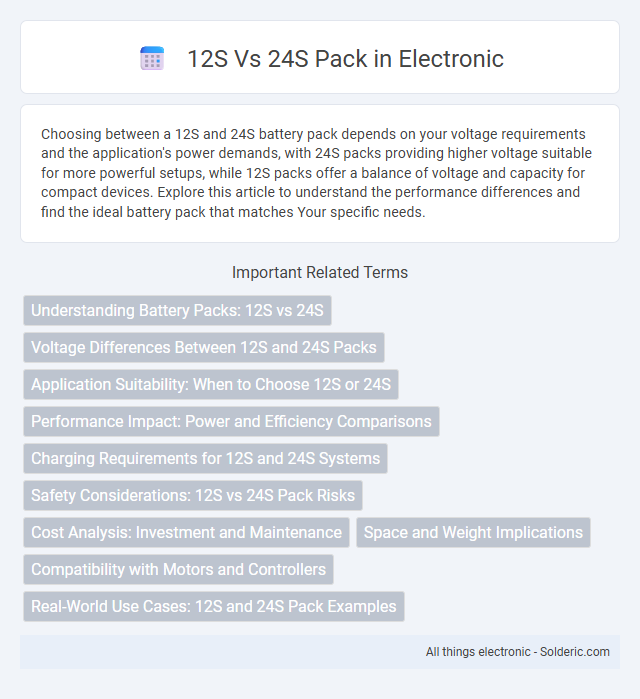Choosing between a 12S and 24S battery pack depends on your voltage requirements and the application's power demands, with 24S packs providing higher voltage suitable for more powerful setups, while 12S packs offer a balance of voltage and capacity for compact devices. Explore this article to understand the performance differences and find the ideal battery pack that matches Your specific needs.
Comparison Table
| Feature | 12S Pack | 24S Pack |
|---|---|---|
| Cell Count | 12 cells in series | 24 cells in series |
| Voltage (Nominal) | 44.4V (3.7V per cell) | 88.8V (3.7V per cell) |
| Voltage (Max Charge) | 50.4V (4.2V per cell) | 100.8V (4.2V per cell) |
| Typical Application | Electric bikes, small electric vehicles | Electric motorcycles, high-power applications |
| Weight | Lighter, easier to manage | Heavier, requires robust management |
| Energy Capacity | Lower total pack voltage and energy | Higher total voltage and energy storage |
| Cost | Lower cost due to fewer cells | Higher cost due to more cells and complexity |
Understanding Battery Packs: 12S vs 24S
A 12S battery pack consists of 12 lithium-ion cells connected in series, providing a nominal voltage of about 44.4V, while a 24S pack doubles this configuration for approximately 88.8V, offering higher power output and efficiency. Your choice between 12S and 24S depends on the application's voltage requirements, with 24S packs favored for high-performance electric vehicles and 12S packs suited for moderate power needs. Battery management systems in both configurations ensure safety and longevity by monitoring voltage, temperature, and state of charge across all series cells.
Voltage Differences Between 12S and 24S Packs
A 12S battery pack typically provides a nominal voltage of around 44.4V (3.7V per cell), while a 24S pack delivers approximately 88.8V, effectively doubling the voltage output. Higher voltage in 24S packs enables increased power and efficiency for electric vehicles and devices, but also requires components rated for higher voltage levels to ensure safety and reliability. Voltage differences directly influence performance parameters such as speed, torque, and energy consumption, making the choice dependent on specific application requirements.
Application Suitability: When to Choose 12S or 24S
12S battery packs are ideal for electric bikes and smaller electric vehicles requiring voltages around 44.4V, offering a balance of power and weight for moderate performance demands. 24S packs provide higher voltage at approximately 88.8V, suitable for high-performance electric motorcycles, drones, and advanced robotics needing increased power output and efficiency. Choosing between 12S and 24S depends on the application's voltage requirements, power consumption, and desired energy density.
Performance Impact: Power and Efficiency Comparisons
A 24S battery pack offers higher voltage output compared to a 12S pack, resulting in increased motor power and improved acceleration performance. Efficiency gains in a 24S configuration arise from reduced current draw for the same power output, leading to lower heat generation and longer component lifespan. However, 12S packs typically provide simpler thermal management and cost advantages, balancing overall system efficiency against raw performance metrics.
Charging Requirements for 12S and 24S Systems
12S battery packs require chargers with a voltage output around 50.4V (4.2V per cell) to ensure proper charging without overvoltage risk. In contrast, 24S systems demand chargers delivering approximately 100.8V to safely and efficiently charge the higher series configuration. Your charger must match the pack's voltage specifications to maintain battery health and optimize charging performance.
Safety Considerations: 12S vs 24S Pack Risks
12S battery packs present lower voltage levels, reducing the risk of electric shock and simplifying insulation requirements compared to 24S packs. Thermal management is generally easier in 12S configurations due to lower heat generation, minimizing the chances of thermal runaway and fire hazards. However, 24S packs deliver higher voltage, which demands more robust safety electronics such as voltage monitoring and balancing systems to prevent overcharging and cell damage.
Cost Analysis: Investment and Maintenance
A 12S battery pack generally requires a lower initial investment due to fewer cells and simpler management systems compared to a 24S pack. Maintenance costs for 12S packs tend to be lower, as they involve less complexity in balancing and monitoring individual cell voltages. However, 24S battery packs offer higher voltage output, which may lead to longer lifespan and efficiency gains, potentially offsetting their higher upfront and maintenance expenses over time.
Space and Weight Implications
A 12S battery pack typically offers a more compact and lighter solution, making it ideal for applications where space and weight are critical constraints, such as in drones or electric bicycles. A 24S pack, while providing higher voltage and power output, demands significantly more space and increases the overall weight, affecting portability and efficiency. Understanding your device's spatial capacity and weight tolerance helps determine whether a 12S or 24S battery pack optimally balances performance with physical limitations.
Compatibility with Motors and Controllers
A 12S battery pack, typically rated at 44.4V nominal voltage, is compatible with most mid-range electric motors and controllers designed for moderate power applications. In contrast, a 24S pack doubles the voltage to around 88.8V nominal, requiring motors and controllers specifically engineered to handle higher voltage systems, which improves efficiency and power output but demands components with higher voltage ratings. Ensuring compatibility between the battery pack voltage and the motor-controller specifications is critical to prevent damage and optimize performance in electric vehicles or power tools.
Real-World Use Cases: 12S and 24S Pack Examples
Electric skateboard setups with 12S battery packs typically power motors suited for moderate speeds and torque, ideal for urban commuting and casual riding. The 24S pack configuration delivers higher voltage and power, enabling increased top speeds and acceleration, making it suitable for mountain boards, off-road riding, and high-performance downhill skateboarding. Popular 12S use cases include Boosted Mini X and Meepo V3, whereas 24S setups are common in DIY high-performance builds and brands like DIYeboard's high-speed e-skate models.
12S vs 24S pack Infographic

 solderic.com
solderic.com